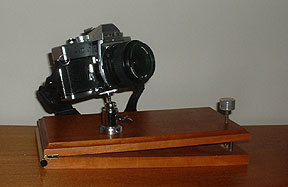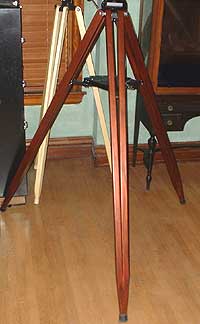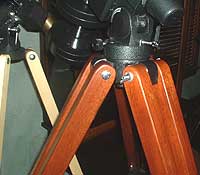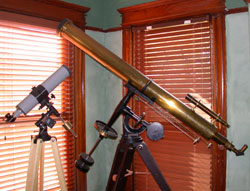Tripods and Wooden Mounts
 The "Scotch" or "Barn-door" mount is incredibly easy to build and will allow you to take time-exposures of the night sky without star trails. The hinged board is mounted on a tripod and the brass sighting tube on the side is used to align the mount with the pole star. The silver knob is turned by hand one revolution per minute during exposure. A small motor can also be used to turn the screw, but it works quite well by hand. For complete instructions on building this mount, follow the link on the last page.
The "Scotch" or "Barn-door" mount is incredibly easy to build and will allow you to take time-exposures of the night sky without star trails. The hinged board is mounted on a tripod and the brass sighting tube on the side is used to align the mount with the pole star. The silver knob is turned by hand one revolution per minute during exposure. A small motor can also be used to turn the screw, but it works quite well by hand. For complete instructions on building this mount, follow the link on the last page.

 Tripods. Wood is still the best!
I recently bought an inexpensive Chinese-made 6-inch refractor. The aluminum tripod it came with was so flimsy that when you let go of the
focusing knob it never really stopped shaking. The wooden tripod that I made has a damping time of about 2 seconds. It's so sturdy that even
if someone bumps it lightly you don't lose the image. I had an unused board of mahogany laying around my shop, but clear poplar works just as
well, is cheaper than anything including clear pine, and is readily available.
Tripods. Wood is still the best!
I recently bought an inexpensive Chinese-made 6-inch refractor. The aluminum tripod it came with was so flimsy that when you let go of the
focusing knob it never really stopped shaking. The wooden tripod that I made has a damping time of about 2 seconds. It's so sturdy that even
if someone bumps it lightly you don't lose the image. I had an unused board of mahogany laying around my shop, but clear poplar works just as
well, is cheaper than anything including clear pine, and is readily available.
After gluing the ends of two 1.5" x 1.75" boards together, I simply turned the end on a belt sander to sharpen it like a pencil. After varnishing the wood with a clear varnish, I slipped a rubber cane tip over the end. This will hold it securely on any surface and keep water from being absorbed into the end grain.
You will note that these tripods are not adjustable. Since I am 6'2" tall, I would never need to make it shorter.
I carry a small wooden stool for shorter people to stand on at star parties. The legs are 68" long.
A simple wooden refractor mount for larger tubes.
 This wooden mount was originally built to hold the five-inch brass refractor shown in the last photo. The wood is 12-ply Finnish birch solid-core plywood. The straps are made from a rubbery type of plastic called butyrate. All the parts were either machined or made in my shop. The two cradles (with the green felt) have a diameter of about 5.5 inches, but they can be easily removed and replaced with larger or smaller cradles. I made one extra strap in case one of the plastic straps broke. It never did, but the buyer can have the extra strap, or replace the straps with metal ones, lined with felt. The measurements of this mount are as follows:
This wooden mount was originally built to hold the five-inch brass refractor shown in the last photo. The wood is 12-ply Finnish birch solid-core plywood. The straps are made from a rubbery type of plastic called butyrate. All the parts were either machined or made in my shop. The two cradles (with the green felt) have a diameter of about 5.5 inches, but they can be easily removed and replaced with larger or smaller cradles. I made one extra strap in case one of the plastic straps broke. It never did, but the buyer can have the extra strap, or replace the straps with metal ones, lined with felt. The measurements of this mount are as follows:
- Diameter of drum on bottom--6 and 3/8 inches. This piece captures two flat teflon plates, and the mount turns on it smoothly.
- Width of large circular turntable--about 11 inches.
- Height of mount--17.5 inches
- Weight--20 lbs.
- Diameter of two circular delrin sleeve bearings--3 inches.
- Length of carriage on top--16 inches.
- Width of carriage--7.25 inches.
- Maximum size of tube this mount will accept--5.5 inches.
- Inside diameter of the two cradles--about 5.3 inches (420mm circumferance).
 Two sleeve bearings were turned from delrin. They allow the cradle to move smoothly, with no incremental slip-stick or backlash.
A tiny bit of talcom powder provides the perfect lubricant and makes this possible.
Two sleeve bearings were turned from delrin. They allow the cradle to move smoothly, with no incremental slip-stick or backlash.
A tiny bit of talcom powder provides the perfect lubricant and makes this possible. Two circular pieces of teflon were acid-etched on one side and glued to the top of the
wooden spindle and the bottom of the turntable. Acid-etching the delrin allowed it to be glued. They turn smoothly and stop with no backlash. You can just barely see the
edge of one of the teflon pieces in this photo on the left.
Two circular pieces of teflon were acid-etched on one side and glued to the top of the
wooden spindle and the bottom of the turntable. Acid-etching the delrin allowed it to be glued. They turn smoothly and stop with no backlash. You can just barely see the
edge of one of the teflon pieces in this photo on the left. The gray plastic straps are made from butyrate. I chose plastic because I didn't want to mar the surface of the antique
brass tube. For a modern scope, I would have used steel straps lined with felt. When you are mounting a big, heavy scope, the steel straps can still bounce around
and scratch the tube.
The gray plastic straps are made from butyrate. I chose plastic because I didn't want to mar the surface of the antique
brass tube. For a modern scope, I would have used steel straps lined with felt. When you are mounting a big, heavy scope, the steel straps can still bounce around
and scratch the tube.  The mount was build to hold this antique 5-inch refractor. I wanted to test the optics of this scope but did not want to risk
setting up the antique mount outdoors. The wooden mount proved to be quite stable and provided a firm support. The quality of the 5-inch lens was impressive. At f/17, it shows
almost no false color.
The mount was build to hold this antique 5-inch refractor. I wanted to test the optics of this scope but did not want to risk
setting up the antique mount outdoors. The wooden mount proved to be quite stable and provided a firm support. The quality of the 5-inch lens was impressive. At f/17, it shows
almost no false color.